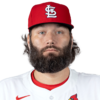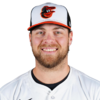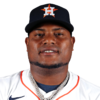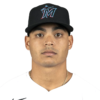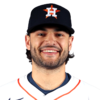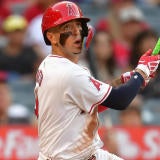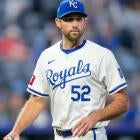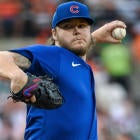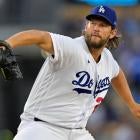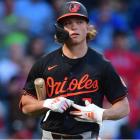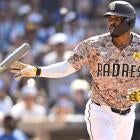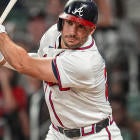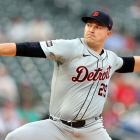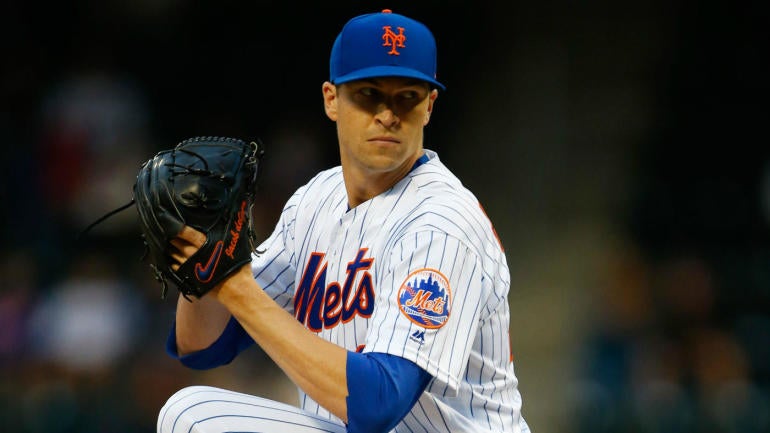
At the risk of oversimplifying, ranking players is mostly just a matter of assessing how good one is relative to another. That's how it works among hitters, anyway.
It's a little different at starting pitcher, where the workload question comes into play. Some pitchers pitch deeper into games than others. Some are allowed to accumulate more innings over the course of a season. Those two groups often intersect, but not always. Deciding who falls into what category is largely subjective, but you can often deduce it based on a pitcher's individual history, his stage of development or his team's tendencies. One of the biggest variables to consider is how many innings he pitched the previous season.
That takes us to 2021, when no one will have thrown many innings the previous season. Teams are typically reluctant to increase a pitcher's workload by more than a couple dozen innings from one season to the next, but coming off a shortened season, most pitchers are looking at an increase of 80-100 innings just to reach the modest threshold of 150.
What about 180? 200? Some pitchers will have to throw that many since not every organization will have enough viable arms to pick up the slack. But how many organizations would be willing to push their younger, more controllable pitchers that hard, potentially compromising them for future seasons?
I don't know how it's going to play out, but I suspect we'll see a bigger innings discrepancy than ever, with some younger, developing arms getting cut off around 100 while some older, more established arms get pushed to closer to 200. It won't be universally true, of course, and so by applying it evenly across the board, I'm bound to miss a few. But as a general rule, I'm emphasizing age and experience at this position because I think it's more likely to hold up over a full season.
Just something to keep in mind as you peruse these early rankings.
We break down the top starters on the Fantasy Baseball Today podcast. Follow all of our podcasts and subscribe here.
Note that these rankings are intended for 5x5 scoring (such as Rotisserie leagues), but I note distinctions for points leagues where applicable.
| 1 |
Shane Bieber
Cleveland Indians SP
|
| True, he outperformed Jacob deGrom in most every preferred statistic -- namely K/9 and xFIP -- but what sets Shane Bieber apart most convincingly is how regularly he works into the eighth inning, allowing him to preserve his own wins. | |
| 2 |
Jacob deGrom
New York Mets SP
|
| Another bump in velocity, which led to an absurd 21.6 percent swinging-strike rate, makes it hard to argue against deGrom as the most talented pitcher in baseball, but it's also hard to overlook the three consecutive seasons of bad win/loss luck. | |
| 3 |
Gerrit Cole
New York Yankees SP
|
| Though pitching for the Yankees makes him a little more vulnerable to the long ball, Gerrit Cole rebounded from an early home run barrage to finish with a much lower ERA (2.84) than he did through the same number of starts (12) with the Astros last year (4.02). | |
| 4 |
Trevor Bauer
Cincinnati Reds SP
|
| Trevor Bauer will rate second to no one in workload, particularly if his new club is on board with him pitching every fourth day, and while a clearer explanation for his 2020 turnaround would be optimal, the fact is he has been Cy Young-worthy two of the past three years. | |
| 5 |
Yu Darvish
Chicago Cubs SP
|
| His improvements from the second half of 2019 carried over, giving Yu Darvish elite strike-throwing ability to go along with elite stuff and, as difficult as it may be to believe given his longstanding inconsistencies, an especially stable ace profile. | |
| 6 |
Aaron Nola
Philadelphia Phillies SP
|
| A bumpy three-start stretch to end the year betrayed what a difference-maker Aaron Nola's refurbished changeup proved to be, giving him his best K/9 rate (12.2) by far and the third best xFIP among qualifiers, behind only Bieber, deGrom and Kenta Maeda. | |
| 7 |
Lucas Giolito
Chicago White Sox SP
|
| Though the consistency was lacking, particularly in terms of walks, the highs for Lucas Giolito were insanely high in his follow-up campaign, highlighted by a no-hitter, six starts with nine-plus strikeouts and the best swinging-strike rate (17.3 percent) this side of deGrom. | |
| 8 |
Max Scherzer
Washington Nationals SP
|
| Max Scherzer is one pitcher whose track record should count for more than a 12-start hiccup, especially since that hiccup manifested as shaky command rather than typical age indicators like reduced velocity or strikeout rate. | |
| 9 |
Clayton Kershaw
Los Angeles Dodgers SP
|
| Having recaptured some of his lost velocity through his work with Driveline Baseball, the arrow is pointed back up for Clayton Kershaw even as he enters his mid-30s, but it's worth noting he had another back flareup this year and remains a likely bet for an IL stint. | |
| 10 |
Luis Castillo
Cincinnati Reds SP
|
| Luis Castillo will have his rough patches but is such a standout in swinging strikes and ground balls that you can trust his numbers will be there in the end. He's also established enough that the Reds probably won't hold back his innings in 2021. | |
| 11 |
Kenta Maeda
Minnesota Twins SP
|
| Anyone who questions Kenta Maeda's ace credentials should note that he placed behind only Bieber and deGrom in xFIP, his increased reliance on his secondary offerings helping unlock new potential as a strike-thrower, a bat-misser and even a ground ball-generator. | |
| 12 |
Jack Flaherty
St. Louis Cardinals SP
|
| A month-long shutdown for a COVID-19 outbreak and one particularly ugly start at Milwaukee prevented Jack Flaherty from performing up to his ace standing, but underlying indicators like velocity, swinging-strike rate and xFIP were all stable. Workload is the one true concern for the 25-year-old. | |
| 13 |
Walker Buehler
Los Angeles Dodgers SP
|
| Though he may be a top-10 talent, the way the Dodgers have babied Walker Buehler the past two years, preventing him from building up to 100 pitches this year, leaves little doubt they'll work to prevent a big increase in innings following the pandemic-shortened season. | |
| 14 |
Zac Gallen
Arizona Diamondbacks SP
|
| In terms of pure talent, he doesn't rate as high as those ahead of him on this list, which puts a natural limit on his ceiling, but Zac Gallen earns high marks for pitchability, navigating seven-inning starts with such efficiency that the workload threat is fairly low for him. | |
| 15 |
Carlos Carrasco
Cleveland Indians SP
|
| While it took him a few starts to find his footing, Carlos Carrasco ultimately proved himself back to form after last year's leukemia bout, going six innings or more in each of his last six starts with a 1.66 ERA, 1.03 WHIP and 10.2 K/9. His age and track record give him fewer workload concerns. | |
| 16 |
Brandon Woodruff
Milwaukee Brewers SP
|
| Apart from Bieber, Brandon Woodruff had the strongest follow-up of any of the 2019 breakthroughs at starting pitcher. While he doesn't have a history of massive innings totals, his workhorse build and tendency to pitch deep into games earns him some benefit of the doubt in that regard. | |
| 17 |
Lance Lynn
Texas Rangers SP
|
| A disastrous final start may have alerted you to the fact that Lance Lynn took a step back as a bat-misser in 2020, but he was on cruise control until then. Plus, you know he's good for the innings, which will count for a lot in 2021. | |
| 18 | 
Dinelson Lamet
San Diego Padres SP
|
| The biceps injury that shut Dinelson Lamet down for the playoffs doesn't seem like a long-term issue but is another reason to suspect the Padres won't let the recent Tommy John patient tack on 100 more innings in 2021, even if he's now looking like Cy Young material. | |
| 19 |
Tyler Glasnow
Tampa Bay Rays SP
|
| Having led the majors with 14.3 K/9 in 2020, Tyler Glasnow's effectiveness is no longer in question, but like with the Dodgers and Buehler, the Rays have been so careful in managing his workload that you know 2021 won't be the year they turn him loose. | |
| 20 |
Stephen Strasburg
Washington Nationals SP
|
| The carpal tunnel surgery that more or less cost him his 2020 is the latest in a long line of injuries for Stephen Stasburg, but it doesn't sound like the nail in the coffin for the 32-year-old, who was arguably the best we've seen him in 2019. | |
| 21 |
Mike Clevinger
San Diego Padres SP
|
| From the dip in velocity to the balky elbow to everything in between, Mike Clevinger's 2020 introduced so many risk factors to his profile that it's hard to imagine enthusiasm will be high for him on Draft Day, but the final tally was nonetheless quite solid. | |
| 22 |
Corbin Burnes
Milwaukee Brewers SP
|
| The top breakout pitcher of 2020, his ERA dropping from 8.82 to 2.11, Corbin Burnes introduced a devastating cutter and saw his control improve upon landing a full-time rotation spot, but he's obviously not built up to handle a full-season workload. | |
| 23 |
Blake Snell
Tampa Bay Rays SP
|
| Between the regular season and playoffs -- a total of 17 starts -- Blake Snell didn't go six innings even once. He remains one of the league's best bat-missers pitch for pitch, but the impact isn't all it could be when he's leaving so many pitches on the table. | |
| 24 |
Zack Greinke
Houston Astros SP
|
| Maybe it would have stabilized over a full-length season, but Zack Greinke looked shaky for much of 2020, and since it corresponded with a dip in velocity, we can't rule out the possibility of decline for the 37-year-old. But we know the Astros will work him. | |
| 25 |
Hyun-Jin Ryu
Toronto Blue Jays SP
|
| Clearly, Hyun-Jin Ryu is just as capable of pitching in the AL East as the NL West, putting up comparable numbers across the board, and while he's not known for his endurance or durability, his veteran status points to him taking on his typical workload in 2021. | |
| 26 |
Zach Plesac
Cleveland Indians SP
|
| In terms of Fantasy points per start, Zach Plesac ranked behind only Bieber and Bauer, but we're talking all of eight starts when you factor in his banishment to the minors for violating team rules. The sample is too small to buy in completely, in other words, though for what it is, it seems legit. | |
| 27 |
Kyle Hendricks
Chicago Cubs SP
|
| New manager David Ross treated Kyle Hendricks a little more like the workhorse he was always destined to be, and clearly, there was no loss of effectiveness, his walk and ground-ball rates improving to the point that the substandard strikeout rate is, frankly, a non-issue. | |
| 28 |
Max Fried
Atlanta Braves SP
|
| Max Fried's low ERA from start to finish helped conceal the many ways he took a step back in 2020, his xFIP rising from 3.32 to 4.05 as his strikeout and walk rates both went the wrong direction, with his starts commonly limited to just five innings. | |
| 29 |
Zack Wheeler
Philadelphia Phillies SP
|
| Zack Wheeler saw an even bigger reduction in strikeout rate than Fried, but it was trending the right direction when the season came to a close. The workload expectations don't really compare either, but I'll give Fried the edge based on perceived upside. | |
| 30 |
Sonny Gray
Cincinnati Reds SP
|
| This season was like a microcosm of Sonny Gray's career, with wild swings in both output and expectations, and while he was certainly better after returning from mid-back strain in late September, the two starts weren't dominant (or thorough) enough to convince me he's fixed. | |
| 31 |
Framber Valdez
Houston Astros SP
|
| Perhaps the most unlikely breakout pitcher of 2020, Framber Valdez had a better xFIP than Trevor Bauer and the best ground-ball rate among all pitchers. It's tempting to rank him ahead of Fried, given Valdez's superior strikeout numbers, but it's possible his control abandons him again. | |
| 32 |
Dylan Bundy
Los Angeles Angels SP
|
| This year certainly delivered the Dylan Bundy we always hoped for, which is perhaps a testament to his change of scenery or the bigger parks of the AL West, but seeing as he still had his hiccups and has faked us out in the past, a more conservative ranking is in order. | |
| 33 |
Jose Berrios
Minnesota Twins SP
|
| The book on Jose Berrios heading into 2020 was that he was an efficient strike-thrower who consistently worked deep into games, but he didn't live up to that assessment. It's likely the unusual buildup threw off his control, because little in his profile changed otherwise. | |
| 34 |
Chris Paddack
San Diego Padres SP
|
| My biggest takeaway for Chris Paddack this year is that we probably overhyped him, presuming improvement rather than observing the warning signs, and it turns out he needs more than a two-pitch arsenal and mediocre swinging-strike rate. The upside is still there, though. | |
| 35 |
Ian Anderson
Atlanta Braves SP
|
| Between six regular season starts and four postseason starts, there's a reasonable enough sample to suggest Ian Anderson is a big bat-misser who's already comfortable making heavy use of his secondary arsenal but may get in trouble with the walks on occasion. | |
| 36 |
Sixto Sanchez
Miami Marlins SP
|
| Another midseason call-up who also saw postseason action, Sixto Sanchez is a bit safer than Anderson as a superior strike-thrower with elite ground-ball tendencies, but it's not so clear he's going to be of much help in strikeouts even though his stuff is visually striking. | |
| 37 |
Jesus Luzardo
Oakland Athletics SP
|
| Jesus Luzardo failed to live up to the hype as a rookie, but more because of actual performance than any coddling by the Athletics. He had a good whiff rate with both of his secondary pitches, though, and generally did a good job of finding the strike zone, so there's still plenty to like here. | |
| 38 |
Lance McCullers
Houston Astros SP
|
| Struggling for most of his return from Tommy John surgery, Lance McCullers started to look more like himself after a brief IL stint for a neck issue, getting back to throwing his curveball nearly 50 percent of the time and sustaining the improved strikeout rate into the playoffs. | |
| 39 |
Patrick Corbin
Washington Nationals SP
|
| Patrick Corbin seemed like one of the more bankable aces after consecutive seasons of stud numbers, but a dip in velocity and drastic reduction in swinging strikes caused his 2021 to unravel. Here's a good spot to gamble it was just a fluke caused by an unconventional season. | |
| 40 |
Charlie Morton
Tampa Bay Rays SP
|
| The Rays especially seemed to take an atypical approach to building up their pitchers following the shutdown, which might explain why Charlie Morton's performance was so uneven and his workload so limited. As with Corbin, the track record justifies a roll of the dice here. | |


















